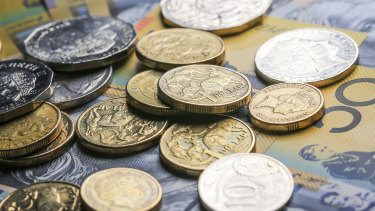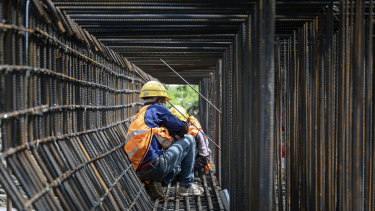Why the Aussie dollar is booming amid a trade spat with China
Judging by the sounds emerging from embassies and trade ministries, you’d think one of China’s most important economic relationships was on the rocks. But currency markets are predicting it’s on the verge of another boom.
The Australian dollar hit its highest level in more than two years on Thursday, capping a 29 per cent rally from its nadir in late March. The moves come after data showed the country emerging from recession in the September quarter. That’s a remarkable contrast to the gloomy political picture, where Australia and its biggest trading partner, China, have been locked in a deepening cycle of conflict for months.

After China unofficially put imports of half-a-dozen categories of Australian products on hold last month, already-tense relations have worsened. More than 50 coal ships have been waiting a month or more off Chinese ports to deliver their cargo. A diplomat in Beijing this week tweeted a fake photograph of an Australian soldier holding a knife to the throat of an Afghan child, a reference to an ongoing investigation of war crimes allegedly committed by the country’s special forces. Tencent Ltd.’s WeChat, which has about 690,000 users in Australia, blocked a Chinese-language message responding to the controversy from Prime Minister Scott Morrison.
Forget the sturm und drang. Australia’s exports to China, after breaking previous records in each of the past five years, will repeat the trick again in 2021. It’s not hard to see why when you look at the numbers.
More than half of Australia’s total exports to China consist of just one product: iron ore. That trade has been on a tear over the past year, with Beijing employing its usual strategy of industrial stimulus to grow its way out of a coronavirus-induced downturn. Brazil, the second-biggest exporter after Australia, has been hit hard by the pandemic, and thus hasn’t been able to increase shipments enough to keep up with demand. Prices for iron ore are at around seven-year highs.
There’s little to suggest this trade will recede over the coming months. While the median analyst forecast has Singapore-traded ore averaging $US92 a tonne in 2021, compared with $US102 this year, forward pricing implies a figure of $US116.64.
The pace of revenue growth in China’s steel-intensive engineering and construction sector isn’t set to peak until the first half of next year, according to Fitch Ratings. Even after that, expansion will continue. Shares in Australian iron-ore miner Fortescue Metals rose more than 13 per cent on Thursday after Brazil’s Vale put out downbeat production targets for this year and next.
Coal, the second-biggest export, is a dicier proposition. President Xi Jinping has promised to move China to net zero emissions by 2060. As we’ve written, it wouldn’t take much for China to be entirely self-sufficient in soot, a proposition that’s out of the question in the case of iron ore. Coal is also on the list of products subject to Beijing’s unofficial import ban.
Still, even there the prospects are surprisingly rosy. Australian thermal and coking coal is far cheaper than its Chinese-produced equivalent, a fact that’s been exacerbated by the current embargo as supply dwindles and mainland prices rise. Utilities, especially in coastal provinces with good port access, prefer imported product. Those pleas will only get louder as Beijing pushes forward with deregulating its power market, shrinking revenue for coal-fired generators and encouraging them to reduce their costs by seeking out cheaper fuel. vaccinations open up borders again.
Australia’s third-biggest export to China is education, which has been hard-hit by the pandemic. Some 166,206 Chinese students are enrolled at Australian universities, but more than half that number are currently stuck outside the country, according to an October study. The population of Chinese students living in Australia fell by about 25,000 between March and October. A substantial slice of education “exports” consists of money spent on rent and shopping. As the receding outbreak causes in-country student numbers to rise again – and the first such flight touched down in Darwin this week – export revenue will increase too.

For all the bad blood between Australia and China these days, those links may prove surprisingly resilient. Students are more or less bound to return when they’ve paid for multiyear courses. Tourists, too, seem to let bygones be bygones far more readily than politicians. A war of words over South Korea’s deployment of a US anti-missile shield caused Chinese tourist visits to drop by nearly 50 per cent from a year earlier in 2017. The following year, however, numbers grew 15 per cent, and then 26 per cent again the year after that.
Put those major items of commerce together and they represent roughly $US100 billion ($134 billion) in exports, far more than the $US15 billion or so on China’s target list of banned goods, including $US792 million of wine. Even there, the damage is unlikely to be lasting. The list, after all, is unofficial, and Chinese customs agents have already started letting some coal cargoes through.
For all the tension between Australian and Chinese politicians, commercial links are as strong as ever – and, indeed, are likely to deepen over the coming 12 months as the coronavirus pandemic recedes. That’s reason to worry a little less about the rhetoric, and focus more on the solid fundamentals. As Adam Smith once pointed out, our economic fortunes don’t depend on our partners’ benevolence, but their self-interest.
Bloomberg
Business Briefing
Start the day with major stories, exclusive coverage and expert opinion from our leading business journalists delivered to your inbox. Sign up for the Herald‘s here and The Age‘s here.
Most Viewed in Business
Source: Thanks smh.com